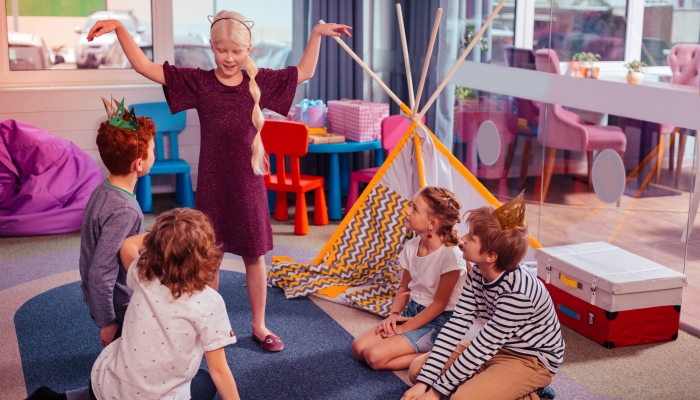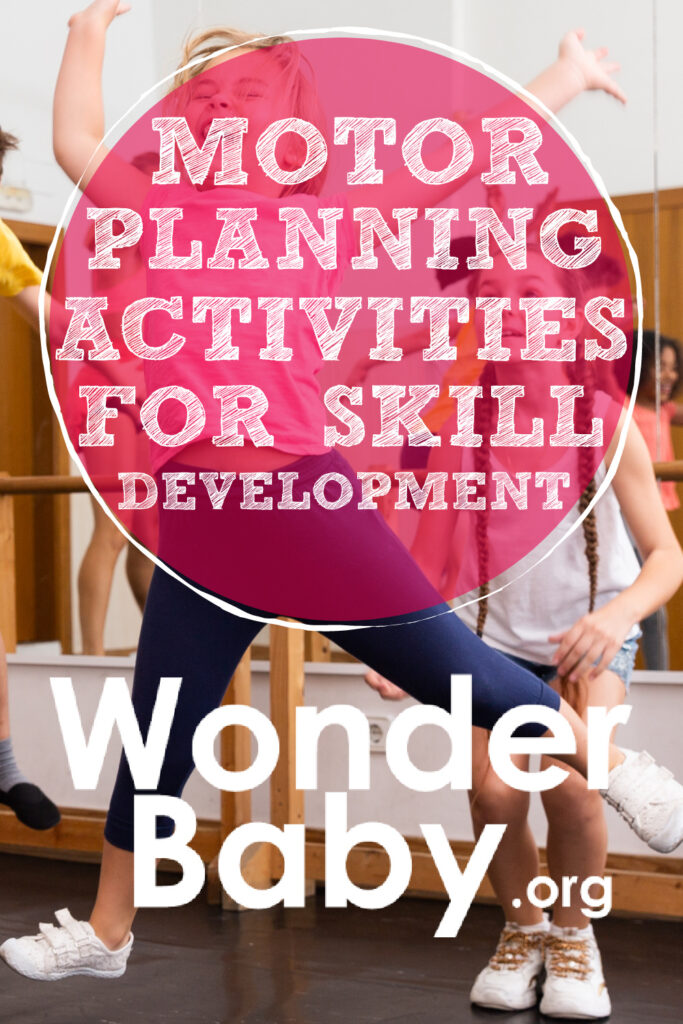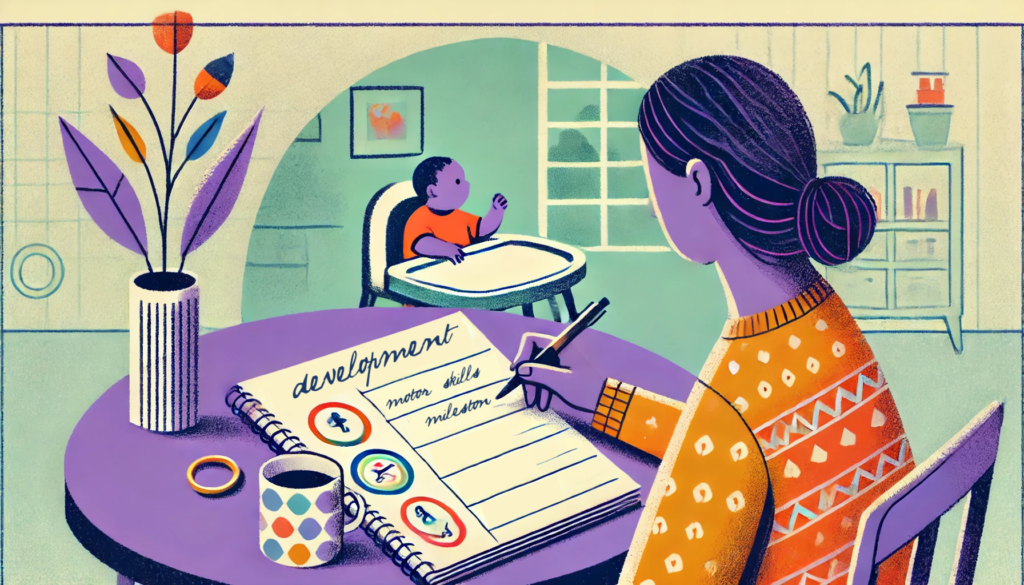5 Motor Planning Activities for Skill Development

This post may contain affiliate links; please see our terms of use for details.
- Motor planning is when the brain gets instructions for a physical task, creates an idea of the motor actions needed to attempt the task, and corrects those motor actions as the body receives sensory feedback.
- Motor planning is a part of motor learning that eventually will produce motor programs, or memories, when practiced frequently.
- Problems with motor planning may be referred to as dyspraxia and can result in slowness to learn and complete physical tasks, poor coordination, and even difficulties with social interaction.
If you’ve ever seen a child on the playground that lags behind their friends, tripping, and playing in a way that looks clumsy and unskilled, you may be observing motor planning difficulties. If you have ever been this child, you understand how hard it is to feel like you’re falling behind your peers or left out of activities.
What you’ve observed, or felt, may be a challenge with motor planning, or putting movements together from start to finish in a coordinated way. Thankfully, motor planning can often be improved with openness to trying new activities and lots of practice!
What Is Motor Planning?
The attempt to complete movements that are not habitually performed is motor planning. Unfamiliar tasks require that we observe the task, develop an idea about it, create a motor plan, and then attempt that motor plan while making corrections based on sensory feedback.
While this sounds like a time-consuming and conscious process, much of motor planning happens quickly and without stopping to think through every step of the movement.
During and after a task, adjustments to the motor plan are made based on sensory information the brain receives. Sensory input provides valuable information about how fast, accurate, and efficient the first motor plan was.
As a particular task is practiced repeatedly, motor coordination improves and your child should get better and better at that task. Over time the brain stops making a new motor plan for that task and instead relies on a motor memory, a motor program that is more automatic and refined than motor plans.
Motor programs become like walking is to most adults—physical activities that are performed without thinking and without needing correction.

How Do Children Learn Motor Planning Skills?
When newborns perform movements, they are often reflexive. The brain has not yet started to use sensory information efficiently, so newborns are not able to do complex motor sequences.
However, as the relationship between incoming sensory input and outbound motor actions strengthens, babies will attempt increasingly difficult motor planning challenges.
As motor plans become motor programs, or permanent “schematics” for motor tasks, children begin to achieve high level gross and fine motor milestones like rolling, grasping, and walking. Eventually, their motor planning skills become advanced enough that their brains will quickly develop motor plans when faced with new gross motor activities.
In some children motor planning issues persist into childhood or adulthood and result in poor coordination and slowness to learn new physical tasks.
Why Is Motor Planning Important in Child Development?
Being able to successfully motor plan provides the building blocks for children to learn new gross and fine motor skills. Many motor skills are essential everyday tasks like walking, writing, self feeding, and more!
If your child has difficulty with motor planning, they may perform these tasks slowly and with poor coordination, possibly even requiring assistance to take of their basic mobility and hygiene needs.
Interestingly, motor planning challenges are frequently related to challenges with social skills and learning. This may be related to the difficulty sequencing actions. Children may also have social struggles because of language dyspraxia or because they have trouble keeping up with their peers at school and in play.
How to Tell if Your Child Struggles With Motor Planning
Motor planning difficulties are sometimes referred to as dyspraxia or developmental coordination disorder. Like some gross motor delays, dyspraxia does not always have a clear cause, though certain diagnoses like cerebral palsy or autism are commonly linked to issues with motor planning. Certainly, any injury to the brain may result in the poor neural connections that lead to motor planning challenges.
In the absence of a medical diagnosis or history of trauma, you may still be able to recognize the signs of dyspraxia.
A child with motor planning difficulties may appear to:
- Be clumsy or uncoordinated.
- Take a long time to complete tasks.
- Complete complex skills out of sequence or have difficulty understanding the order of an activity.
- Not easily learn new motor skills.
- Run into things or fall frequently.
- Also have difficulty with, and avoid, social interaction.
If you notice any of these signs with your child, contact their pediatrician to express your concerns.
Your child may be referred to a pediatric occupational therapist who can work with your child to improve motor planning, body awareness, and sensory processing. In some cases, a pediatric physical therapist may also address motor planning and coordination difficulties, particularly if gross motor skills like walking are affected.
5 Activities to Boost Your Child’s Motor Planning Skills
Outside of occupational therapy appointments, there are plenty of fun activities you can do with your child to build their motor planning skills! Many of these activities can be used to try unfamiliar motor tasks, improve hand-eye coordination, and develop motor control. The best part is, your child won’t even know they are working hard!
1. Charades
- Classic game designed for kids, but great for the whole family to play together!
- Cards have clues with pictures, making this easy for non-readers, but also reinforces early reading skills
- 3 levels of play allow younger players to participate while still making it challenging enough for older players
- Stimulating game gets kids moving around as they have fun acting out clues
This classic game provides endless opportunities to have your child try new movement skills! You might find a pre-made version of Charades or create cards of your own.
Each person draws a card with an action, movie, book, phrase, etc. and must silently act out what’s on the card until the other person guesses correctly or time runs out. This game can be played on teams for added fun.
Since your child has to consciously correct their movements during the game to get you to guess correctly, motor learning may be enhanced.
2. Simon Says
You are Simon and tell your child what movements to perform while demonstrating. If you fail to say “Simon says” and the child moves, they are out of the game! Demonstrating the movements adds an element of sensory processing that will help your child with creating motor plans.
Similar to charades, you can use your creativity to give your child new movement tasks with each game. If you’d like to progress their motor learning, use familiar movements in new sequences each time as the challenge.
3. Dance
- DURABLE & ANTI-SLIP: Made of heavy-duty vinyl material; toxin-free and soft padded; easy to wipe clean; durable enough for endless dancing and jumping; non-slip pattern on the back; designed in HK, US patent registered
- 3 LEVELS DIFFICULTY: Follow the beat of the built-in music; dance to the cues of the blinking LED board; challenge yourself with 3 different levels; kids receive music and light feedback with every step; fun for girls ages 3 4 5 6 7 8 9 10; requires 3 AA batteries (not included)
- PORTABLE & EASY TO STORE: Measures 35.4″ x 36.6″; easily folds for convenient storage in a closet or under the bed; makes toy collection easier for parents and kids; fits perfectly into a bag for outings; suitable for both indoor and outdoor use
- DEVELOPMENTAL BENEFITS: Encourages kids to exercise in an entertaining way; promotes collaboration and physical activity; facilitates interaction and cooperation between parents and children; suitable for both kids and adults
Dancing is a skill that requires rhythm, coordinating complex body movements, and sometimes following a choreographed plan. You can make up dance routines to challenge your child’s motor planning skills, but you can also simply turn on the music and let them enjoy moving to the beat.
Using a mirror or videoing their dance can provide added feedback for their dance party, but take care not to be too critical. There are also video games with dance competitions that provide immediate visual feedback to your child on whether they are doing the movements correctly.
4. Agility Ladder
- 20 Feet 12 Rungs Agility Ladder:The agility ladder comes with 12 sturdy plastic rungs, and the overall length is 20 feet
- Adjustable Agility Rung Design: Each rung is 16.5″ long, and the space between rungs is adjustable up to 15″ inch. You can simple adjust it in the nylon straps so as to meet your workout demands in grass ground or playground
- Include Carrying Bag Training Set: The agility ladder comes with a carrying bag, which is very convenient for you to train anytime anywhere
- Ideal Tool for Outdoor Sports Training: The agility ladder is very helpful for footbald, soccer, basketball drills, hockey, tennis, etc as it can increase your speed, leg strength and improve your balance ability
An agility ladder is a mobile ladder that is placed on the floor and used to builds skills in coordination, speed, changes in direction, and rhythm. You may even have seen them in NFL training videos! Try activities like placing each foot in each square quickly, jumping to each square, jumping sideways in and out of the squares, or hopping on one foot.
5. Animal Walks
There are quite a few kinds of animal walks, like crab walking, bear walking, duck walks, and more. Crab walking has your child belly up with hands and feet on the floor, bear walking is belly down with hands and feet on the floor, and duck walks are walking in a low squat that looks like a duck’s waddle.
Even with practice these exercises can be difficult as they require a high degree of bilateral coordination and strength to perform correctly. If your child has sensory processing issues, animal walks also make great heavy work providing calming input and sensory input to the hands, feet, and core.
FAQs
How does motor planning affect learning?
Motor planning can affect learning in various ways, either directly affecting the learning process or affecting your child’s ability to interact with the learning environment.
Since motor planning is related to sequencing actions, difficulty with this aspect of motor planning can directly affect academic learning. A child with sequencing difficulties may have trouble putting ideas into a logical order or completing school tasks step by step.
If language dyspraxia is involved, your child may have trouble communicating with their teacher and peers. They may benefit from communication devices and speech therapy that can improve reciprocal conversation abilities.
If your child is struggling with motor planning as related to motor skills, they may struggle to move through the classroom, learn to write, cut with scissors, etc. Though lacking these skills does not necessarily mean your child has a learning disability, they may fall behind in the classroom because they take longer to complete tasks.
What is the difference between motor planning and coordination?
Motor planning and coordination are closely linked, but are subtly different. Motor planning involves attempting a movement from observation of the task and formation of a concept of the movement to execution and improvement of the the task.
Coordination is the ability to move in a way that is efficient and accurate. Coordination primarily involves the execution and correction of the movement more so than the observation and ideation components of motor planning.

The information WonderBaby provides is not intended to be, and does not constitute, medical or other health advice or diagnosis and should not be used as such. Always consult with a qualified medical professional about your specific circumstances.
Related Posts

Development, Special Needs
How to Track Milestones for Developmentally Delayed Babies
Parents of developmentally delayed babies can explore practical tools and strategies to track milestones, celebrate progress, and support their child’s unique developmental journey.

Fine and Gross Motor
5 Alternatives to Tummy Time for Babies with Motor Development Challenges
Does your baby struggle with tummy time due to motor development challenges? These alternatives to tummy time will offer the same benefits.

Development
Should Twins Share a Room?
Wondering if your twins should share a room? We’ll explore the pros and cons of room-sharing for twins right here before you make your decision.


